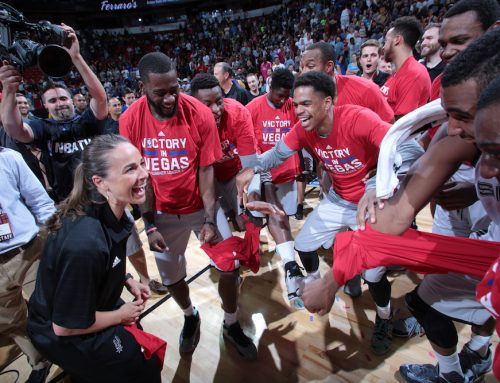Welcome to NBA.com/Stats
via stats.nba.com By Brian Martin
With today’s launch of NBA.com/Stats, the NBA is giving fans the opportunity to analyze the game on a much deeper level by placing the world of advanced statistics at your fingertips.
Whether you’re already a basketball stats geek that wants nothing more than to crunch numbers for hours or a fan of the game that’s curious to learn more about all these advanced metrics that you keep hearing about — this site is for you.
So how does this all work? The stats database is built on top of the official NBA play-by-play data that is tracked courtside during every game — this includes every point, rebound, assist, steal, block, turnover, missed shot, foul and substitution, the point in the game when each one these events occurred and which players were on the floor when it happened.
Let’s start on the homepage, which opens with a look at the league leaders in a variety of statistical categories. You have the option to view the data as a grid if you just want to see the raw numbers, or as a chart if you prefer to visualize how the leaders compare to each other in the selected categories.

You will notice a League Average line that cuts across the chart. This line is calibrated so that it represents the NBA-wide average for each of the categories displayed, so you can see how much better or worse these players are compared to each other and the average NBA player at the same time.
In the chart above, you’ll see that the Points tabs is selected, which determines the stats categories that are presented in the chart — in this case Points, True Shooting Percentage, Field Goal Percentage, 3-Point Field Goal Percentage and Free Throw Percentage. If you hover over any bar on the chart, the stat for that player and the league average will display.
You can also switch between tabs to see the league leaders in every aspect of the game — Rebounding, Assists, Defense, Playmaking,Efficiency, Clutch and Shooting. And you’re not limited to comparing players: you can also switch to the Teams view to see how the teams stack up against one another as well.
Did you miss last night’s games and want to check out the box scores to see what happened? No problem. We have last night’s box scores, not to mention every box score in the history of the league going all the way back to 1946. Additionally, we also have a shot chart for every game played from 1996 to today, so not only can you see the numbers, you can see where each shot was taken to analyze shooting performance from different scoring zones.
Over the past two weeks, Miami’s LeBron James has put together a stretch of games that put him in the record books, as he became the first player ever to score at least 30 points while shooting at least 60 percent in six consecutive games — all wins for the Heat.
From LeBron’s player page on NBA.com/Stats you can find all of the information you need to break down this outstanding achievement.
We’ll start with the overall base stats on the player page, which gives us a look at the type of season stats that have been used for decades. One item of note here is his Field Goal Percentage of 56.5%, which is the highest in his career by over three percentage points. If you look at LeBron’s career stats, you will see his FG% has increased nearly every year he has been in the league, with the only exception being the 2006-07 season.
While his entire season has been impressive, we want to focus on the past six games, so we’re going to check his splits for the games played between Feb. 3 and Feb. 12.
Looking at the Base stats above, we see his ridiculous shooting percentages over the past six games — 71.7% from the field and 55.6% from three — as well as his +/- of +90.
By pulling up the advanced stats above, we can take an even deeper look at LeBron’s play. A few items to note:
126.9 OffRtg: The Miami Heat are scoring 126.9 points per 100 possessions while LeBron is on the court over this six-game span. For the season, the Heat as a team has a league-best offensive rating of 110.4, while LeBron’s rates at 112.8 for the year.
77.2 eFG%: Effective Field Goal Percentage accounts for the fact that three-point shots are worth more than two-point shots, which pushes LeBron’s already incredible 71.7 FG% up to 77.2%
30.7 USG%: Usage Percentage measures the amount of team plays used by a player while he is on the floor. For the season, LeBron’s USG% is 29.8%, so the Heat are going to him slightly more often than normal, but for the most part, LeBron is just being more efficient with the touches that he normally gets.
25.7 PIE: The NBA’s PIE (Player Impact Estimate) statistic measures a player’s overall statistical contribution against the total statistics in games they play in. LeBron already leads the league in PIE for the season with a mark of 21.6%.
You can also check the Scoring tab to see where and how he is scoring. Here you can see that 60.5 percent of his points have come on two-point field goals and of those field goals 11.9 percent have come from mid-range (outside the key, but inside the three-point line) and 48.6 have come in the paint.
Not enough detail? Let’s keep going to the Shooting tab. We need to know shot distance (in five foot increments, in eight foot increments), scoring zones (restricted area, mid-range, corner three, etc.), shot types (alley-oop dunk, jump shot, hook shot, banked shots, tip-ins, etc.) and whether or not the shots were assisted.
If you’re looking for more than just the numbers, then check out the Shot Chart for LeBron over the six-game stretch to see exactly where he’s been the most successful. You’ll notice a lot of green in this chart; it’s hard to have many cold zones when you’re shooting 71.7%.


As well as LeBron has played over this six-game span, he didn’t do this by himself. Let’s take a look at the Heat’s five-man lineups during this time period.
It’s not surprising that LeBron was part of the four most-used Heat lineups during this period. It is interesting to see that the third most-used lineup of Battier, Bosh, Chalmers, James and Wade shot the lights out compared to the other lineups. You’ll notice that this lineup was only on the floor together for 21 minutes over three games during this six-game period. Remember that the Heat were without some of their players over the past few weeks due to illness.
The page above looks at the Base stats for each of the Heat lineups. Remember, you can also check the Advanced Stats, Scoring Zones, Four Factors as well as look at how their Opponents fared as well.
As you can see, there is a wealth of data now at your disposal to help see the game from entirely new angles. Take a look around and create your own analysis here on NBA.com/Stats.









